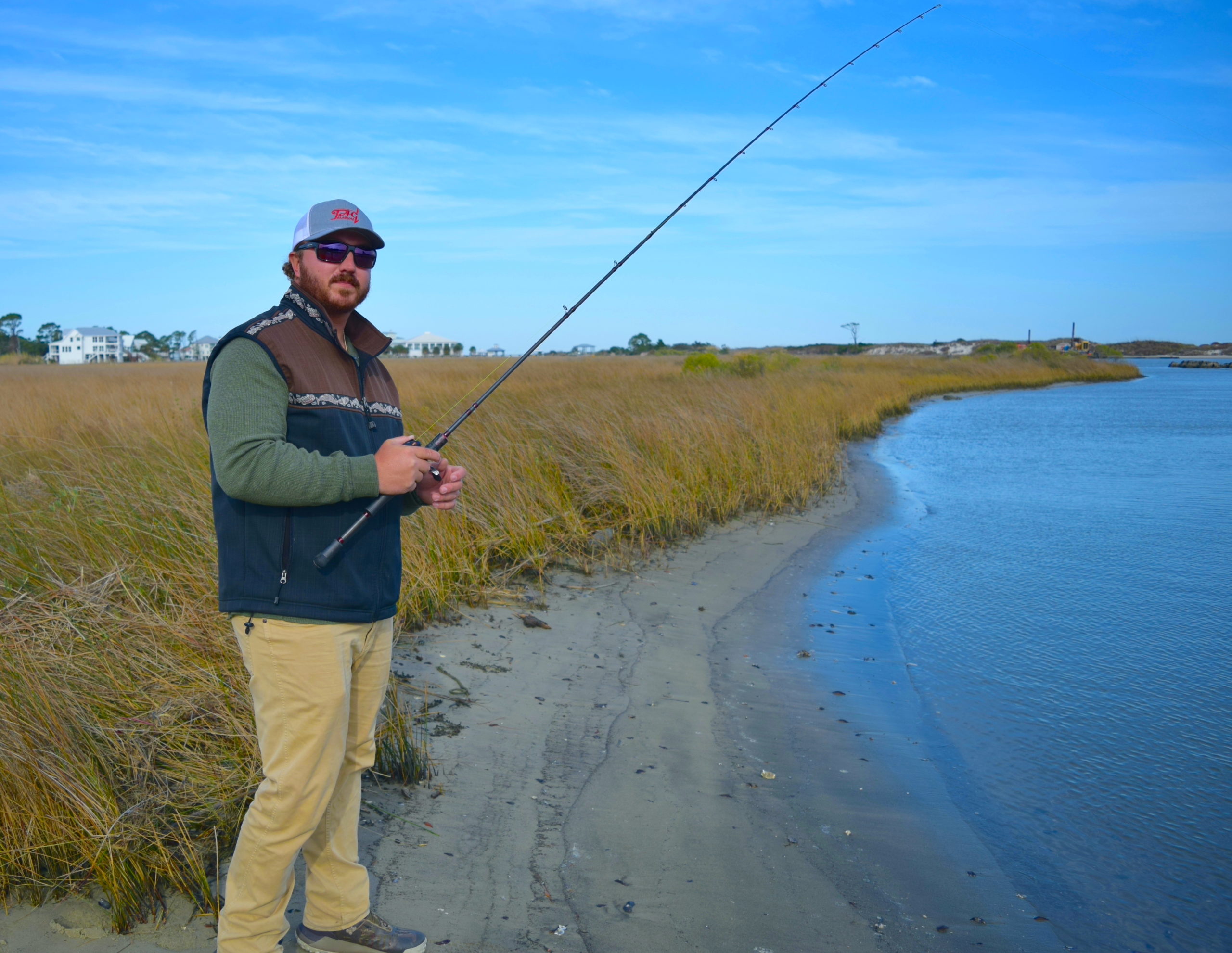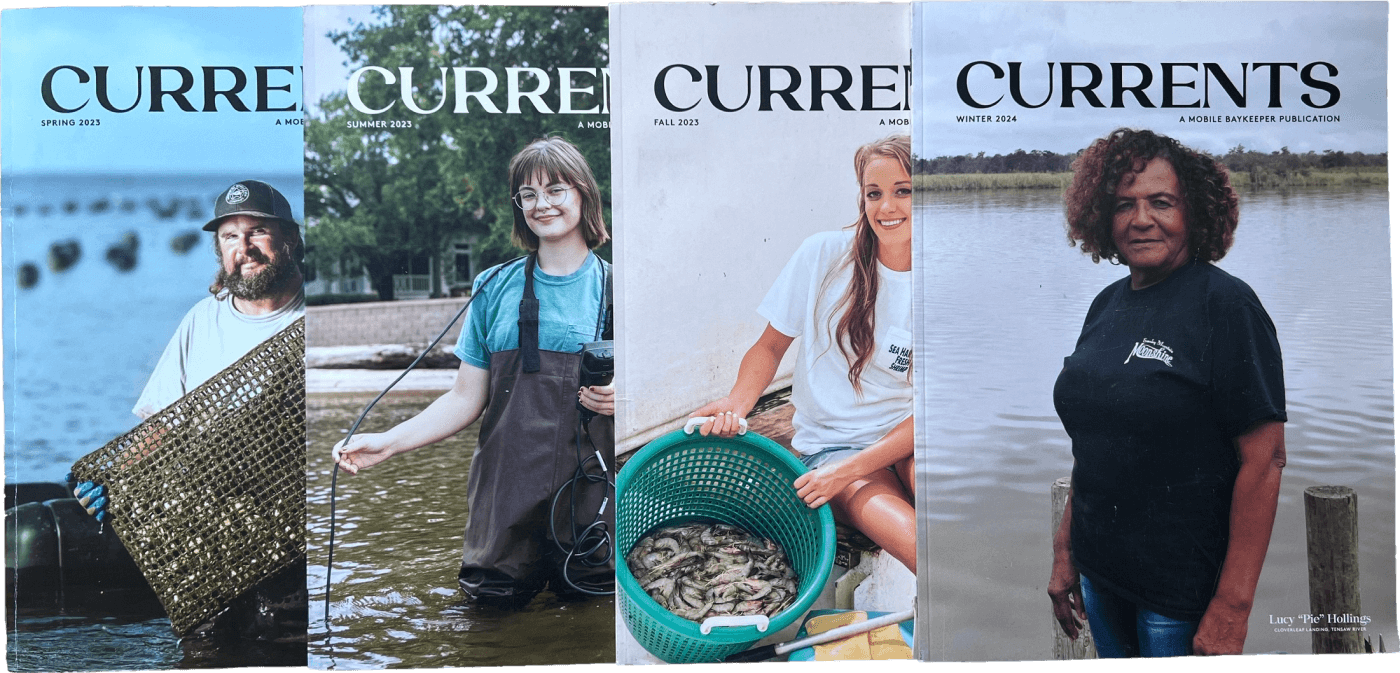
This article is from the spring 2024 edition of Mobile Baykeeper’s print quarterly, CURRENTS. The magazine is mailed to active members who have given more than $50 in the past year. To get on the magazine’s mailing list, donate here.
by Cassie Bates | Photo by Caine O’Rear
A native of the Mobile area, Dylan Kiene is a Ph.D. student in the Fisheries Ecology Lab within the Stokes School of Marine and Environmental Sciences at the University of South Alabama. His research and expertise revolve around flounders and other types of flatfish in Coastal Alabama and Alaska. He is currently the project lead for the Coastal Alabama Acoustic Monitoring Program for flounder migration.
Flounders exhibit unique characteristics, but what is so attractive about swimming sideways?
As an ambush predator, it is beneficial to be on the bottom because it creates an element of surprise. Flounders can control their skin cells to change colors and produce camouflage so they can truly be selective about when to strike prey. From a fishing standpoint, I would say that flounders are prideful, because when they hit your bait, they aren’t letting go. They have just grown accustomed to being successful, so when they commit, they are all in.
What kinds of flounder do we have in Coastal Alabama? What is the best way to catch and cook them?
Offshore, we have around 18 species such as Dusky, Mexican, Shrimp, and Shoal flounders. However, there are two main species which support fisheries which are the Gulf and Southern flounders.
To catch them, you can use a Carolina rig and 6-to-10-inch leader on casting or spinning reels. Finger mullet, pogies, and shrimp are all highly effective live-bait choices for targeting flounder. For the tagging program, we use artificial lures that present a thin fish or shrimp profile in the water. It is important to scent your lures as flounders have a strong sense of smell.
My dad’s favorite way to prepare flounder was to do an egg wash, roll in panko breadcrumbs, and butter sear. If you prefer frying, then beer batter is also a great choice. You can even leave the flounder whole, which I think is one of the best ways because you can get so much more out of the animal. You can stuff or score it and it really creates quite the centerpiece for a table.
Do you think enough work is being done to investigate reasons behind fish kills?
From a scientific standpoint, many researchers are very interested in the causation of fish mortality events. However, in terms of having a large-scale project dedicated to answering this question, more could be done. For example, we still do not know if the shipping channel or other human impacts may lead to fish kills. I think we should consecutively monitor conditions so that when a kill happens, we can isolate potential drivers. If we find out that this is a preventable water-quality issue, then we absolutely should be working to fix that issue as fast as possible.
What research does the Coastal Alabama Acoustic Monitoring Program support and what are you learning from it?
Our team monitors redfish, speckled trout, and flounder movements with acoustic tags. We can manipulate a receiver array to help us answer questions about migration, mortality, and seasonal influences on movement.
One of the most interesting things I have learned is that flounder are sexually dimorphic, meaning that males and females behave like two different species. They exhibit different growth rates and life expectancies and have different habitat preferences. For example, after almost reaching maturation, male flounders will move offshore and never return in their lifetimes, whereas females only leave estuaries during the spawning season. This means that almost any flounder you have ever caught inshore is more than likely a female.
Flounders also imprint and return to rivers and estuaries they grew up in by using a “homing” ability. Waterways have individual fingerprints which flounder can differentiate from one another. This instinct is so strong that I have witnessed tagged flounders make a 100-mile journey which begins and ends at the very same rock. These findings are being used by the state agency to better inform closure plans. For example, our data has demonstrated that 70 percent of migrating flounder are moving in November, which is why there is a species-specific closure for this month to protect them during this critical period.
Do you know if Mobile Bay is experiencing any breakdowns between resources and flounder populations?
In terms of food availability, Mobile Bay is extremely productive. I believe that we could support much larger fisheries than we currently do solely based on our resources. Unfortunately, the loss of key habitat can really degrade productivity for flounder populations. Young flounders require low salinity marsh nurseries in the Mississippi Sound, Point Aux Pins, Fowl River, and the Delta, so it is incredibly important to protect these areas. However, living shorelines like the Nature Conservancy Lightning Point project seem to be a great solution as we have seen juvenile flounders utilizing the restoration site.
Between crafting custom reels and advocating for fisheries conservation culture, it’s clear you are passionate about fish and angling. What sparked this fascination?
My dad. He loved fishing, and I think in a different life he would have gone into fisheries, but fortunately for the marine chemistry world he became passionate about microbial processes. He made a career studying DMSP, which is a powerful antioxidant produced by plankton to protect them from environmental stressors. Bacteria in the ocean eat this compound and transform it into a gas which plays a huge role in atmospheric climate regulation.
He worked at the Dauphin Island Sea Lab, and I remember fishing together on the docks when I was younger. During this time, we saw a decline in the flounder fishery, and I became interested in understanding how this could happen. Now I am pursuing a Ph.D., leading flounder monitoring efforts, and helping state managers with fishery decisions. Really, if it weren’t for my dad instilling this conservation knowledge in me, I am not sure I would be where I am today. I am truly blessed to be able to pursue this career, and I wish my dad could see the recovery in the flounder fishery now.
What fishing pressures are especially detrimental to flounder populations?
Gigging is one of the most intense forms of flounder fishing because it takes place in areas where flounders seek refuge at night. It can be deceiving when you wade and see hundreds of them, but that is because that place of congregation may support a much larger area. The act of gigging is not bad; in fact, it is an important legacy fishing method for our area. Although people have been doing it for a long time, the issue is that gigging, with its technological advancements, does not scale well for flounder. Instead of wading out on foot, shallow water specialist boats will hit the water with LED light systems which can light up the length of a football field. It’s easy pickings at that point, and when you have hundreds of people killing 40 flounders a night, it’s a pretty simple way to screw up the fishery.
What is the one thing people can do to help protect our flounder populations?
Be conservative and harvest with a purpose, and always let go of what you do not need. A small-catch goal mentality gives flounders a chance to return and strengthen the overall productivity of the fishery. I started an angler-based tagging program where fishermen and women can tag excess fish, so when they let them go, they are still connected with them. Educate yourself, and understand flounder movements and life history, so that you can become fully aware of what you are removing and how you play a role in protecting it for future generations.
Please report tagged fish online at tags.usouthal.edu.
